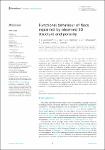Functional behaviour of flocs explained by observed 3D structure and porosity
| dc.contributor.author | Lawrence, TJ | |
| dc.contributor.author | Carr, SJ | |
| dc.contributor.author | Manning, AJ | |
| dc.contributor.author | Wheatland, JAT | |
| dc.contributor.author | Bushby, AJ | |
| dc.contributor.author | Spencer, KL | |
| dc.date.accessioned | 2023-11-16T23:57:14Z | |
| dc.date.available | 2023-11-16T23:57:14Z | |
| dc.date.issued | 2023-01-01 | |
| dc.identifier.issn | 2296-6463 | |
| dc.identifier.issn | 2296-6463 | |
| dc.identifier.uri | https://pearl.plymouth.ac.uk/handle/10026.1/21655 | |
| dc.description.abstract |
Clay-rich flocculated suspended sediments are an important constituent of estuarine and coastal systems globally. They are responsible for the host, movement and deposition of a variety of pollutants, contaminants and sediment itself. Accurate modelling of the movement of these sediments is crucial for a number of industries including fisheries, aquaculture, shipping and waste management. This requires an accurate and reliable measurements of the physical properties of flocs and their behaviour. Porosity is a key element in floc structures, and this research provides updated 3D quantified porosity and pore space morphological data in relation to influences on floc settling behaviour. We report the questionable relationship between floc size and settling velocity, and explore alternative influences such as floc composition, porosity and pore morphology. These outcomes suggest that a shift in focus from floc size to a combination of factors is necessitated to understand the complex movement behaviour of flocculated suspended sediments. | |
| dc.format.extent | 1264953- | |
| dc.publisher | Frontiers Media SA | |
| dc.subject | 37 Earth Sciences | |
| dc.subject | 3705 Geology | |
| dc.title | Functional behaviour of flocs explained by observed 3D structure and porosity | |
| dc.type | journal-article | |
| dc.type | Journal Article | |
| plymouth.volume | 11 | |
| plymouth.publication-status | Published online | |
| plymouth.journal | Frontiers in Earth Science | |
| dc.identifier.doi | 10.3389/feart.2023.1264953 | |
| plymouth.organisational-group | |Plymouth | |
| plymouth.organisational-group | |Plymouth|Research Groups | |
| plymouth.organisational-group | |Plymouth|Faculty of Science and Engineering | |
| plymouth.organisational-group | |Plymouth|Faculty of Science and Engineering|School of Biological and Marine Sciences | |
| plymouth.organisational-group | |Plymouth|Research Groups|Marine Institute | |
| plymouth.organisational-group | |Plymouth|REF 2021 Researchers by UoA | |
| plymouth.organisational-group | |Plymouth|Users by role | |
| plymouth.organisational-group | |Plymouth|Users by role|Academics | |
| plymouth.organisational-group | |Plymouth|REF 2021 Researchers by UoA|UoA07 Earth Systems and Environmental Sciences | |
| plymouth.organisational-group | |Plymouth|REF 2028 Researchers by UoA | |
| plymouth.organisational-group | |Plymouth|REF 2028 Researchers by UoA|UoA07 Earth Systems and Environmental Sciences | |
| dcterms.dateAccepted | 2023-09-26 | |
| dc.date.updated | 2023-11-16T23:57:14Z | |
| dc.rights.embargodate | 2023-11-18 | |
| dc.identifier.eissn | 2296-6463 | |
| rioxxterms.versionofrecord | 10.3389/feart.2023.1264953 |


